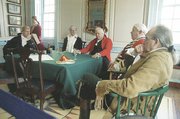For British General Edward Braddock, invading the French-controlled "Ohio Country" was serious business. It was not something to be hastily thrown together or — even worse — underfunded. So when he arrived in Alexandria to meet with several colonial governors at the Carlyle House in the spring of 1755, the 35-year military veteran argued that the colonists should be charged for the services provided by his army. But the colonial governors hated the idea and vetoed the plan in Carlyle’s dinging room, insisting that only Parliament could issue taxes.
"I guess we’ll never know if Braddock was right," said Jim Bartlinski, director of the Carlyle House Museum. "Maybe the invasion would have been more successful if it had been better funded. It’s just one of those things we’ll have to wonder about."
After alienating the colonial governors of Virginia, Maryland and Pennsylvania, Braddock met with a delegation of Indian chiefs to explain their historic claims to land in the Ohio Valley were worthless and that the mighty British army had no use for savage. This prompted most of the tribes in the region to side with the French, further contributing to the impending disaster. By the time the general found himself in a pitched battle in modern-day Pittsburg, he had created a no-win situation.
"As Braddock saw it, he commanded the largest and best equipped military force ever assembled on the North American continent, making victory inevitable," wrote historian Joseph Ellis in "His Excellency." "In fact, the campaign was doomed from the start."
<b>THE ARGUMENTS THAT</b> unfolded in the dining room of the Carlyle House would have dramatic influence in the events of what is know known as the "French and Indian War" — a misleading name considering the British and the French were the opponents with Indian allies fighting on both sides. Understanding the conflict can be difficult because the complex motives involved from the various participants. But a visit to the Carle House on April 14 will bring the arguments of that era into vivid relief.
Since 2005, the museum has been conducting reenactments of the famous meeting John Carlyle referred to as "the Grandest Congress held at my home ever known on this Continent." The event features reenactors in period costume portraying the governors arguing with Braddock about money and strategy. Outside the house, visitors can experience soldiers drilling on the lawn with firearms, rifles and cannon. A number of female "camp followers" will also be on hand.
"There was always a good number of women who followed the men around," said Sarah Coster, curator at the museum. "They did the cooking and the laundry and a number of other chores."
<b>THIS YEAR</b>, unlike previous reenactments, the museum is planning an "after-action report" to conclude the day’s events. Unfortunately, it’s kind of an anti-climatic ending. After Braddock's men crossed the Monongahela, a force of fewer than 900 French and Indians met them. Braddock was killed when he rode into a friendly fire zone in an attempt to prevent the British regulars from firing at the Virginia militia. The star of the after-action report is sure to be 23-year-old George Washington, who rode into the hail of bullets to stop the British from firing at the Virginians before leading the retreat.
"We’re hoping the after-action report will put the whole event in context," said Bartlinski. "It’ll certainly make the discussion between Braddock and the governors more poignant."
